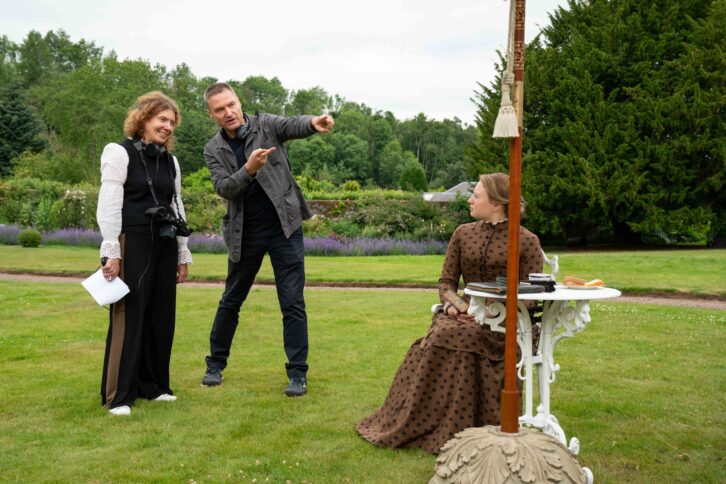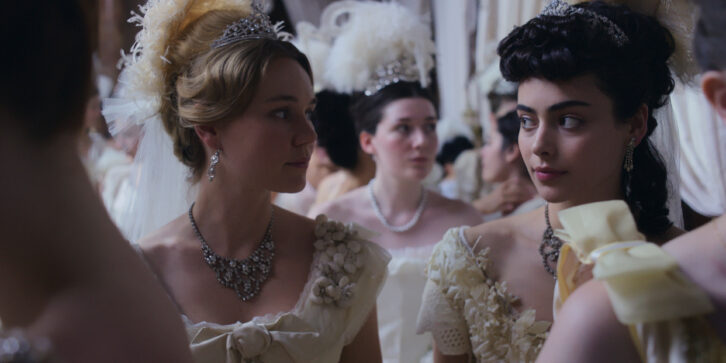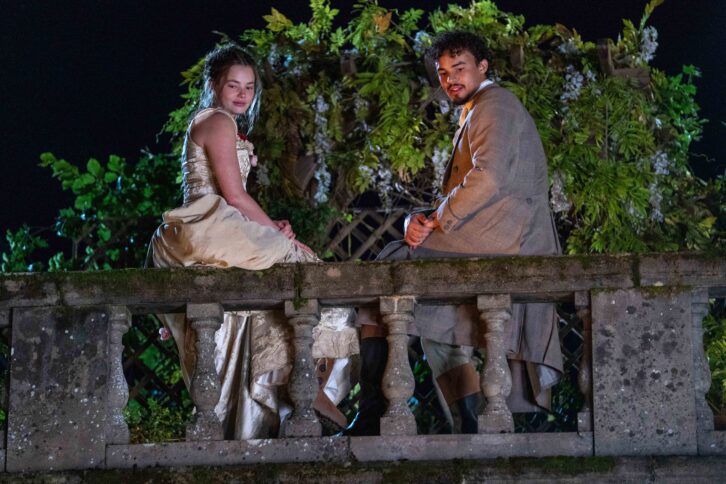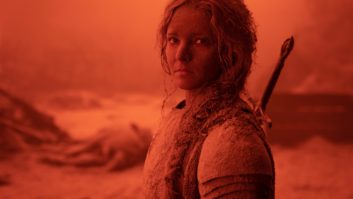It is a truth universally acknowledged that the traditional period drama involves dashing men, simpering women, and lots of candlelight.
But in recent years there’s been a move towards contemporizing the intrigue of 18th-century romance for modern audiences, see Netflix’s Bridgerton.
Taking a leaf out of Lady Whistledown’s book is Apple TV Plus’ adaptation of Edith Wharton’s unfinished novel, The Buccaneers, which follows five American young ladies who travel to England in search of husbands.
The series has been created by Katherine Jakeways, with directors Susanna White, Richard Senior and Charlotte Regan taking a block of episodes each.
For the show’s first two episodes, White brought in cinematographer Oliver Curtis to establish the look.”Because the story journeys from New York to London, we also had to design and configure how that journey would take place visually,” Curtis tells TVBEurope. “So it was about changing and developing lighting, colour, costume and movement to express what the characters were going through in their journey from one country to another.”

The series begins in New York, with what Curtis describes as a heightened sense of colour, saturation and movement. “The 1870s was a period in America where electric light was coming in. The New World was burgeoning and these families had new wealth,” he explains. “So there was a great deal of optimism and energy. We tried to capture that spirit with all of our tools.
“As they come to the UK, the story is that these wealthy women are coming over to meet gentlemen with titles who are nearly all slightly down on their luck,” he continues. “The England that they find is not dreary, but more drained of colour, and a little bit more staid and stiff and with deeper shadows literally and metaphorically.
“From a cinematography point of view, it’s a great opportunity to have a development of that kind in quite a short space of time, because most of that journey takes place in episodes one and two. So it was my task to set up the world that we find ourselves in, to establish some of the rules of the grammar, of the lensing, and of the lighting to get the audience into that space.”
Curtis is keen to emphasise that while the first two episodes establish the look of the show, he wanted the directors and cinematographers who followed to be able to take the show in another direction if they wanted to, in order to mirror the changes in the characters’ lives. “It would be counterproductive if things stylistically didn’t change,” he says. “We weren’t prescriptive about how they would take the look forward, but we did maintain the cameras and lenses so there was that level of continuity in terms of the visual language of the piece.”
Curtis chose to shoot on ARRI’s ALEXA LF Large Format cameras coupled with the company’s DNA lenses. “They’re vintage lenses that have a wonderful quality and beautiful fall off towards the edges,” he explains.
“Initially, I had an idea of shooting New York with anamorphic lenses and then going spherical for the UK. But I think Apple felt that was possibly going a little bit too far stylistically,” Curtis adds. “So I thought, okay, if I don’t go anamorphic, how can I have this subtle adjustment in the look and the depth of field? So we went with Canon K35 lenses in New York and then came to the ARRI DNAs in the UK. I worked with Simon Surtees at ARRI Rental in London to detune a number of the lenses so that if we chose to, we could work at a wider aperture and get some interesting characteristics with fall-off and distortion from that wonderful glass.”
The choice of lenses also enabled Curtis to get up close and personal with the actors to pick up moments of heightened emotion. “I’m not one for shooting wide open,” he says. “I guess it’s my film background. I think particularly when you’re shooting faces in close-up, you’ve got to hold enough depth of field to allow the performer’s expressive qualities to come through. Plus the ARRI sensor is really beautiful for skin tone, so it felt very much the right combination for this show.”

Curtis shot his episodes with two cameras for the majority of the time, and he pays tribute to the operators. “Alex Brambilla and Sebastian Barraclough on A camera and Laura Dinnett on B camera all did terrific work. Only one shot is going to be on screen at any one time, and I don’t know which moment the editor is going to use, so I was very keen to get the maximum I could out of both cameras and to capture spontaneity, performance, reaction, particularly in scenes of ensemble performance, which we have many.
“The opening episode in New York includes a society wedding, so you’ve got shots of five or six people reacting to the same thing and, just having that one lens is fine, but there may be moments within that you can get and you don’t want to have to just reset to capture that moment. The B camera is extremely useful in picking up those little moments and keeping the pace up and keeping the spontaneity of what the actors are doing.”
While working as the cinematographer, Curtis was also his own lighting director. Almost every period drama features an array of candles due to the fact that electricity wasn’t available in most English homes. But Curtis says he didn’t want to use lots of candlelight just for the sake of it. “I wanted to feel like the candles were doing something in terms of illuminating the room. But nevertheless, we had to use a lot of modern lighting technology to achieve what we needed to achieve.
“I tried to involve a lot of LED sources so that we were low on power consumption but inevitably some of the large halls and spaces required large cherry pickers and so on to bring the light into gloomy corners. I’d say the lighting package was a hybrid of HMIs, LEDs, and quite a lot of balloon lights. Oftentimes we’d float balloons into the spaces and give them skirts so they kept the lighting off the walls. It’s a classic tool for negotiating that kind of space. Occasionally I’d have my electricians tow them around during the shot so I could shift the light and the level where I needed to be. My approach was very much a naturalistic one, but slightly heightened.”

Curtis adds that his aim with the lighting is to ensure the audience doesn’t become aware of the process of illumination, instead, he wants them to feel as though the world they’re watching is self-lit by oil lamps, candles, and windows. “Inevitably, you have to depart from that and there are moments when there is a more stylized beat perhaps in the drama and you’re lighting for a feeling rather than for a genre convention or verisimilitude,” he says. “You have to go with what’s needed storytelling-wise. If there was a fire in the room I wanted the audience to feel the fire quality on the characters’ faces. If there were candles, I wanted it to feel like the candles were doing the work that you’d expect them to do in that space.”
Curtis took inspiration from a number of sources, including Stanley Kubrick’s Barry Lyndon, La Reine Margot by Patrice Chereau, Sofia Coppola’s Marie Antoinette and even some contemporary shows like Sex in the City and Friends. “Those shows have an ensemble cast riffing off each other and being playful,” he explains, “I think we managed to capture some of the vitality of this story by being open to those moments.”
Asked what he’s most pleased with about his two episodes, Curtis returns to the subject of portraiture. “We have such a beautiful cast of young men and women with such expressive faces. I just love looking at faces and watching performance and working out how best to light them in the time and the space that I have,” he says.
“A lot of the time in cinematography we sort of herald the big wide shot with shafts of light coming through. But sometimes the most powerful work is right in the actors’ eyes. I love crafting the highlight, deciding how much shape to put in, negative fill, positive fill, and at the same time allowing the actor to do what they need to do in that very small space. For me, the portraiture is something that I look forward to every day.”
Episodes 1-3 of The Buccaneers are available to stream on Apple TV Plus now, with the rest following weekly.






